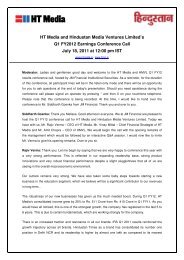Download latest annual report - HT Media
Download latest annual report - HT Media
Download latest annual report - HT Media
Create successful ePaper yourself
Turn your PDF publications into a flip-book with our unique Google optimized e-Paper software.
Annual Report 2011-12<br />
106<br />
unrecognized deferred tax assets. It recognizes<br />
unrecognized deferred tax assets to the extent that it<br />
has become reasonably certain or virtually certain, as<br />
the case may be, that sufficient future taxable income<br />
will be available against which such deferred tax assets<br />
can be realised.<br />
The carrying amount of deferred tax assets are<br />
reviewed at each balance sheet date. The Group<br />
writes-down the carrying amount of a deferred tax<br />
asset to the extent that it is no longer reasonably certain<br />
or virtually certain, as the case may be, that sufficient<br />
future taxable income will be available against which<br />
deferred tax asset can be realized. Any such write-down<br />
is reversed to the extent that it becomes reasonably<br />
certain or virtually certain, as the case may be, that<br />
sufficient future taxable income will be available.<br />
Deferred tax assets and deferred tax liabilities are offset,<br />
if a legally enforceable right exists to set off current tax<br />
assets against current tax liabilities and the deferred tax<br />
assets and deferred tax liabilities relate to the taxes on<br />
income levied by same governing taxation laws.<br />
Minimum Alternate Tax (MAT) paid in a year is<br />
charged to the statement of profit and loss as current<br />
tax. The Group recognises MAT credit available as an<br />
asset only to the extent there is convincing evidence<br />
that the Group will pay normal Income-tax during<br />
the specified period. In the year in which the Group<br />
recognises MAT credit as an asset in accordance with<br />
the Guidance Note on Accounting for Credit Available<br />
in respect of Minimum Alternative Tax under the<br />
income-tax Act, 1961, the said asset is created by way<br />
of credit to the statement of profit and loss and shown<br />
as ‘MAT Credit Entitlement’. The Group reviews the<br />
‘MAT Credit Entitlement’ asset at each <strong>report</strong>ing date<br />
and writes down the asset to the extent the Group does<br />
not have convincing evidence that it will pay normal<br />
tax during the specified period.<br />
q) Earnings Per Share<br />
Basic Earnings per Share are calculated by dividing<br />
the net profit or loss for the year attributable to Equity<br />
Shareholders (after deducting preference dividend and<br />
attributable taxes) by the weighted average number<br />
of equity shares outstanding during the year. The<br />
weighted average numbers of equity shares outstanding<br />
during the year are adjusted for events of bonus issue,<br />
bonus element in a rights issue to existing shareholders,<br />
share split and reverse share split (consolidation of<br />
shares) that have changed the number of equity<br />
shares outstanding, without a corresponding change in<br />
resources.<br />
For the purpose of calculating Diluted Earnings Per<br />
Share, the net profit or loss for the year attributable to<br />
equity shareholders and the weighted average number<br />
of shares outstanding during the year are adjusted for<br />
the effects of all dilutive potential equity shares.<br />
r) Employee Stock Compensation Cost<br />
Measurement and disclosure of the employee sharebased<br />
payment plans is done in accordance with SEBI<br />
(Employee Stock Option Scheme and Employee<br />
Stock Purchase Scheme) Guidelines, 1999 and the<br />
Guidance Note on Accounting for Employee Sharebased<br />
Payments, issued by the Institute of Chartered<br />
Accountants of India. The Company measures<br />
compensation cost relating to employee stock options<br />
using the intrinsic value method. Compensation cost<br />
is amortized over the vesting period of the option on a<br />
straight line basis.<br />
s) Cash and Cash equivalents<br />
Cash and Cash equivalents in the cash flow statement<br />
comprise cash at bank and in hand and short term<br />
investments with an original maturity of three months<br />
or less.<br />
t) Segment Reporting Policies<br />
Identification of segments<br />
The Group’s operating businesses are organized<br />
and managed separately according to the nature of<br />
products and services provided, with each segment<br />
representing a strategic business unit that offers<br />
different products and serves different markets. The<br />
analysis of geographical segments is based on the<br />
areas in which major operating divisions of the Group<br />
operate.<br />
Inter segment Transfers<br />
The Group generally accounts for intersegment sales<br />
and transfers as if the sales or transfers were to third<br />
parties at current market prices<br />
Allocation of Common Costs<br />
Common allocable costs are allocated to each segment<br />
on a rational basis based on nature of each such<br />
common cost.<br />
Unallocated Items<br />
Unallocated items include general corporate income<br />
and expense items which are not allocated to any<br />
business segment.<br />
Segment Policies<br />
The Group prepares its segment information in<br />
conformity with the accounting policies adopted for<br />
preparing and presenting the financial statements of<br />
the Group as a whole.<br />
u) Contingent liabilities<br />
A contingent liability is a possible obligation that arises<br />
from past events whose existence will be confirmed<br />
by the occurrence or non-occurrence of one or more<br />
uncertain future events beyond the control of the<br />
Group or a present obligation that is not recognized<br />
because it is not probable that an outflow of resources<br />
will be required to settle the obligation. A contingent<br />
liability also arises in extremely rare cases where there<br />
is a liability that cannot be recognized because it cannot<br />
be measured reliably. The Group does not recognize<br />
a contingent liability but discloses its existence in the<br />
financial statements.<br />
v) Expenses incurred on Initial Public Offer (IPO)<br />
Expenses incurred in Initial Public Offer are adjusted<br />
against the securities premium account.





